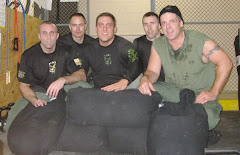Wednesday, March 31, 2010
Tuesday, March 30, 2010
no weight work out: 03/30
Monday, March 29, 2010
Sunday, March 28, 2010
Saturday, March 27, 2010
Friday, March 26, 2010
Thursday, March 25, 2010
Wednesday, March 24, 2010
Tuesday, March 23, 2010
Monday, March 22, 2010
Sunday, March 21, 2010
Can I enjoy optimal health without being an athlete?
no weight work out: 03/21
Saturday, March 20, 2010
no weight work out: 03/20
Friday, March 19, 2010
Thursday, March 18, 2010
Wednesday, March 17, 2010
Monday, March 15, 2010
Saturday, March 13, 2010
no weight work out 03/14
Four rounds:
run 400 meters
30 lunges
Remember what I talked about when running, run like you are being chased!!
Friday, March 12, 2010
no weight work out: 03/12
Thursday, March 11, 2010
no weight work out: 03/11
Wednesday, March 10, 2010
Tuesday, March 9, 2010
Monday, March 8, 2010
Sunday, March 7, 2010
Saturday, March 6, 2010
Carbohydrate intake?
300 or more grams/day - Danger Zone!
Easy to reach with the “normal” American diet (cereals, pasta, rice, bread, waffles, pancakes, muffins, soft drinks, packaged snacks, sweets, desserts). High risk of excess fat storage, inflammation, increased disease markers including Metabolic Syndrome or diabetes. Sharp reduction of grains and other processed carbs is critical unless you are on the “chronic cardio” treadmill (which has its own major drawbacks).
150-300 grams/day – Steady, Insidious Weight Gain
Continued higher insulin-stimulating effect prevents efficient fat burning and contributes to widespread chronic disease conditions. This range – irresponsibly recommended by the USDA and other diet authorities – can lead to the statistical US average gain of 1.5 pounds of fat per year for forty years.
100-150 grams/day – Primal Blueprint Maintenance Range
This range based on body weight and activity level. When combined with Primal exercises, allows for genetically optimal fat burning and muscle development. Range derived from Grok’s (ancestors’) example of enjoying abundant vegetables and fruits and avoiding grains and sugars.
50-100 grams/day – Primal Sweet Spot for Effortless Weight Loss
Minimizes insulin production and ramps up fat metabolism. By meeting average daily protein requirements (.7 – 1 gram per pound of lean bodyweight formula), eating nutritious vegetables and fruits (easy to stay in 50-100 gram range, even with generous servings), and staying satisfied with delicious high fat foods (meat, fish, eggs, nuts, seeds), you can lose one to two pounds of body fat per week and then keep it off forever by eating in the maintenance range.
0-50 grams/day – Ketosis and Accelerated Fat Burning
Acceptable for a day or two of Intermittent Fasting towards aggressive weight loss efforts, provided adequate protein, fat and supplements are consumed otherwise. May be ideal for many diabetics. Not necessarily recommended as a long-term practice for otherwise healthy people due to resultant deprivation of high nutrient value vegetables and fruits.
Please visit this link, great information.....
http://www.marksdailyapple.com/the-primal-carbohydrate-continuum/
no weight work out: 03/06
Thursday, March 4, 2010
My friend Lou and I think the same most times in regards to fitness and conditioning. I want to share what he posted on his blogpage, trinitytraining.blogspot.com. Most of you know how I am pretty straight forward with my opinions, this would be a perfect example. We talked about making choices this week with our workout routines and with our food choices. It comes down to "Are you ready for the challenge?" Please share you thoughts.....
Wednesday, March 3, 2010
Tuesday, March 2, 2010
no weight work out: 03/02
Monday, March 1, 2010
Personal Trainers?
Although I’m a technical writer, I also earn a decent living as a part-time personal trainer. It’s what I enjoy doing because it gets me away from the desk and moving around.
I have a list of loyal clients, many of whom have been with me for a decade or so. I’m grateful, but what I find interesting is this:
I tell all of my clients that I cannot help them. Yet year after year they continue to pay me nearly $100 per session.
It is no hiding that most potential clients come to me with one goal in mind: lose fat and get lean.
Well, it took me several years to realize that there was no exercise I can prescribe within my scope of practice as a personal trainer that could help them achieve their goal. In short, I cannot help them lose weight. And I make that clear.
What I tell them, though, is that exercise (particularly resistance training) may improve their health: it can increase insulin sensitivity, regulate their glucose, and improve their mood. It builds muscle and may give their bodies some shape. Exercise may also help them prevent weight or fat gain.
But, exercise will not help them lose weight.
Only eating better and eating less can help them lose weight. Plenty of evidence suggests this.
They understand. And amazingly, this up-front disclaimer and honesty has made my personal training service more valuable to them.
First, it addresses the ambiguity and misinformation so prevalent in the fitness industry: selling people the false hope that exercise causes weight loss, which encourages them to rely on exercise and half-ass their diet.
Second, telling them the facts will effectively remove the exercise-weight-loss BS so that they can finally accept that they are indeed accountable for their eating behavior.
Otherwise, you’ve seen it: clients paying their personal trainers to baby-sit them with hours of cardio, or to beat them to pulps using strength-and-conditioning methods meant for elite athletes, yet they look the same month after month, year after year.
I believe that personal trainers must first devalue themselves as weight-loss experts, in order to increase their value as health and fitness professionals.
